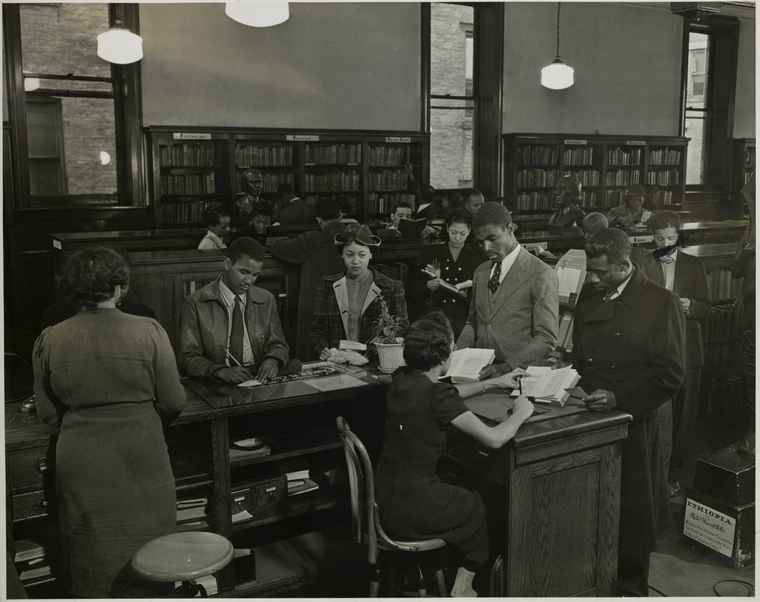Africa and the African Diaspora
The Schomburg Center Clipping Files
This blog post is part of the #SchomburgSyllabus series edited by Zakiya Collier, Digital Archivist, Manuscripts, Archives, and Rare Books Division. The #SchomburgSyllabus project archives Black-authored and Black-related online educational resources to document Black studies, movements, and experiences in the twenty-first century. In connecting these web-archived resources to the Schomburg Center’s own unique materials, the project honors and recognizes the source and strength of Black self-education practices, collective study, and librarianship.The #SchomburgSyllabus is curated by Schomburg Center staff and organized into twenty-seven themes to foster a greater understanding of the Black experience.

The Jean Blackwell Hutson Research and Reference Division’s collection of books, periodicals, serials, microform, and maps equate to over half a million items. However, when researchers come to visit us in Harlem, one of the most popular resources is a collection that has been built personally by the hands of librarians for almost 100 years, the Schomburg Center Clipping Files.
The origins of the clipping files date back to 1924, when Catherine Latimer, the first Black librarian hired at the New York Public Library, realized that there was a need by the community not being fulfilled by the Library’s collections. As described in a review of The Kaiser Index to Black Resources 1948-1986, "reference material on black people was so thin that the resourceful librarians at the Schomburg Library were forced, out of sheer necessity, to create a file of clippings from newspapers and magazines to answer reference questions." This began as a simple card file but grew to hundreds of thousands of items.
The clippings became an invaluable resource for the community and garnered recognition with scholars and other librarians across the country. Black librarians, such as Arna Bontemps at Fisk University, would even send Latimer interesting clippings to add to the files. In the 1930s during the Great Depression, Works Progress Administration (WPA) workers assisted in developing the clipping files by clipping articles and placing them in scrapbooks. Catherine Latimer would purchase any publication that had an article related to Black culture and remove it to add to the scrapbooks. During the Second World War as the the size of the files grew, there was a more organized process to collecting and categorizing the clipping files; they kept a bulletin board to keep clippings up-to-date and "pasted 15 days a month." They were also constantly adding new subject headings to the files.

Although the collecting of clippings and other ephemera, and organizing it into scrapbooks and files, significantly slowed down over the years, the practice continued until the early 2000s. Due to the fragile nature of the newspapers, eventually the items in the scrapbooks were reformatted to microfiche. Although the general collection of clippings has ceased, the use of these files have only increased over time, and they serve many purposes. One example is this Black Bookstores Research Guide, which uses multiple images from the “bookstores'' category of the clipping files.
The creation of the #SchomburgSyllabus can be considered a direct descendant of the clipping files. Instead of searching newspapers and magazines for articles and collecting pamphlets and ephemera, the #Syllabus web archive collection captures born-digital content documenting the Black Experience online. Both of these resources capture the essence of a specific moment in time, and preserve works and other creations that might not otherwise have been archived.
So how can researchers access the Schomburg Center Clipping Files?
- The files are available for use in the Jean Blackwell Hutson Research and Reference Division, one of the five Research Divisions at the Schomburg Center.
- The files are in three parts. The first two parts are only available on microfiche.
- The clipping files from part III are available in their original format.
- There are two indexes (part I and part II ) that allow researchers to easily explore over 7000 subject headings.
Read E-Books with SimplyE
 With your library card, it's easier than ever to choose from more than 300,000 e-books on SimplyE, The New York Public Library's free e-reader app. Gain access to digital resources for all ages, including e-books, audiobooks, databases, and more.
With your library card, it's easier than ever to choose from more than 300,000 e-books on SimplyE, The New York Public Library's free e-reader app. Gain access to digital resources for all ages, including e-books, audiobooks, databases, and more.
If you don’t have an NYPL library card, New York State residents can apply for a digital card online or through SimplyE (available on the App Store or Google Play).
Need more help? Read our guide to using SimplyE.